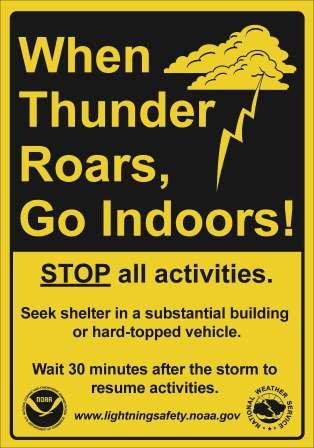When Thunder Roars, Go Indoors!
Each year in the United States, more than 400 people are struck by lightning. On average, between 55 and 60 people are killed; hundreds of others suffer permanent neurological disabilities. Most of these tragedies can be avoided with a few simple precautions. When thunderstorms threaten, get to a safe place. Lightning safety is an inconvenience that can save your life.
The National Oceanic and Atmospheric Administration (NOAA) collects information on weather-related deaths to learn how to prevent these tragedies. Many lightning victims say they were “caught” outside in the storm and couldn’t get to a safe place. With proper planning, these tragedies could be prevented.
Other victims waited too long before seeking shelter. By heading to a safe place 5 to 10 minutes sooner, they could have avoided being struck by lightning.
Some people were struck because they went back outside too soon. Stay inside a safe building or vehicle for at least 30 minutes after you hear the last thunder clap.
Finally, some victims were struck inside homes or buildings while they were using electrical equipment or corded phones. Others were in contact with plumbing, a metal door or a window frame. Avoid contact with these electrical conductors when a thunderstorm is nearby!
What You Might Not Know About Lightning
- All thunderstorms produce lightning and are dangerous. In the United States, in an average year, lightning kills about the same number of people as tornadoes and more people than hurricanes.
- Lightning often strikes outside the area of heavy rain and may strike as far as 10 miles from any rainfall. Many lightning deaths occur ahead of storms or after storms have seemingly passed.
- If you can hear thunder, you are in danger. Don’t be fooled by blue skies. If you hear thunder, lightning is close enough to pose an immediate threat.
- Lightning leaves many victims with permanent disabilities. While a small percentage of lightning strike victims die, many survivors must learn to live with very serious lifelong pain and neurological disabilities.
Avoid the Lightning Threat
Have a lightning safety plan. Know where you’ll go for safety and how much time it will take to get there. Make sure your plan allows enough time to reach safety.
- Postpone activities. Before going outdoors, checkthe forecast for thunderstorms. Consider postponing activities to avoid being caught in a dangerous situation.
- Monitor the weather. Look for signs of a developing thunderstorm such as darkening skies, flashes of lightning or increasing wind.
- Get to a safe place. If you hear thunder, even a distant rumble, immediately move to a safe place. Fully enclosed buildings with wiring and plumbing provide the best protection. Sheds, picnic shelters, tents or covered porches do NOT protect you from lightning. If a sturdy building is not nearby, get into a hard-topped metal vehicle and close all the windows. Stay inside until 30 minutes after the last rumble of thunder.
- If you hear thunder, don’t use a corded phone except in an emergency. Cordless phones and cell phones are safe to use.
- Keep away from electrical equipment and wiring.
- Water pipes conduct electricity. Don’t take a bath or shower or use other plumbing during a storm.
Organized Outdoor Activities
Many people enjoy outdoor activities. It’s essential for the people in charge of these activities to understand the dangers of lightning, have a lightning safety plan in place, and follow the plan once thunder is heard or lightning is seen. Many outdoor activities rely on volunteer leaders, coaches or sports officials to make safety decisions. Make sure the leaders of these activities follow a lightning safety plan. Don’t be afraid to ask, and don’t be afraid to speak out during an event if conditions become unsafe. You could save a life!